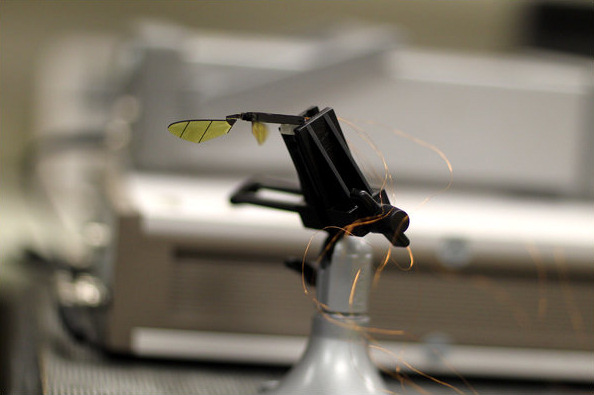 .
.
 .
.
Posted on 03/02/2013 6:09:55 PM PST by Vince Ferrer
The U.S. Department of Homeland Security has customized its Predator drones, originally built for overseas military operations, to carry out at-home surveillance tasks that have civil libertarians worried: identifying civilians carrying guns and tracking their cell phones, government documents show.
The documents provide more details about the surveillance capabilities of the department's unmanned Predator B drones, which are primarily used to patrol the United States' northern and southern borders but have been pressed into service on behalf of a growing number of law enforcement agencies including the FBI, the Secret Service, the Texas Rangers, and local police.
Homeland Security's specifications for its drones, built by San Diego-based General Atomics Aeronautical Systems, say they "shall be capable of identifying a standing human being at night as likely armed or not," meaning carrying a shotgun or rifle. They also specify "signals interception" technology that can capture communications in the frequency ranges used by mobile phones, and "direction finding" technology that can identify the locations of mobile devices or two-way radios. The Electronic Privacy Information Center obtained a partially redacted copy of Homeland Security's requirements for its drone fleet through the Freedom of Information Act and published it this week. CNET unearthed an unredacted copy of the requirements that provides additional information about the aircraft's surveillance capabilities.
Homeland Security's Predator B drone can stay aloft conducting surveillance for 20 hours. (Credit: U.S. Department of Homeland Security) Concern about domestic use of drones is growing, with federal legislation introduced last month that would establish legal safeguards, in addition to parallel efforts underway from state and local lawmakers. The Federal Aviation Administration recently said that it will "address privacy-related data collection" by drones. The prospect of identifying armed Americans concerns Second Amendment advocates, who say that technology billed as securing the United States' land and maritime borders should not be used domestically. Michael Kostelnik, the Homeland Security official who created the program, told Congress that the drone fleet would be available to "respond to emergency missions across the country," and a Predator drone was dispatched to the tiny town of Lakota, N.D., to aid local police in a dispute that began with reimbursement for feeding six cows. The defendant, arrested with the help of Predator surveillance, lost a preliminary bid to dismiss the charges.
"I am very concerned that this technology will be used against law-abiding American firearms owners," says Alan Gottlieb, founder and executive vice president of the Second Amendment Foundation. "This could violate Fourth Amendment rights as well as Second Amendment rights." Homeland Security's Customs and Border Protection agency declined to answer questions about whether direction-finding technology is currently in use on its drone fleet. A representative provided CNET with a statement about the agency's unmanned aircraft systems (UAS) that said signals interception capability is not currently used:
U.S. Customs and Border Protection is not deploying signals interception capabilities on its UAS fleet. Any potential deployment of such technology in the future would be implemented in full consideration of civil rights, civil liberties, and privacy interests and in a manner consistent with the law and long-standing law enforcement practices.
CBP's UAS program is a vital border security asset. Equipped with state-of-the-art sensors and day-and-night cameras, the UAS provides real-time images to frontline agents to more effectively and efficiently secure the nation's borders. As a force multiplier, the UAS operates for extended periods of time and allows CBP to safely conduct missions over tough-to-reach terrain. The UAS also provides agents on the ground with added situational awareness to more safely resolve dangerous situations. During his appearance before the House Homeland Security committee, Kostelnik, a retired Air Force major general who recently left the agency, testified that the drones' direction-finding ability is part of a set of "DOD capabilities that are being tested or adopted by CBP to enhance UAS performance for homeland security." CBP currently has 10 Predator drones and is considering buying up to 14 more.
If the Predator drones were used only to identify smugglers or illegal immigrants crossing the Mexican and Canadian borders, or for disaster relief, they might not be especially controversial. But their use domestically by other government agencies has become routine enough -- and expensive enough -- that Homeland Security's inspector general said (PDF) last year that CBP needs to sign agreements "for reimbursement of expenses incurred fulfilling mission requests."
"The documents clearly evidence that the Department of Homeland Security is developing drones with signals interception technology and the capability to identify people on the ground," says Ginger McCall, director of the Open Government Project at the Electronic Privacy Information Center. "This allows for invasive surveillance, including potential communications surveillance, that could run afoul of federal privacy laws."
A Homeland Security official, who did not want to be identified by name, said the drones are able to identify whether movement on the ground comes from a human or an animal, but that they do not perform facial recognition. The official also said that because the unarmed drones have a long anticipated life span, the department tries to plan ahead for future uses to support its border security mission, and that aerial surveillance would comply with the Electronic Communications Privacy Act and other applicable federal laws.
The documents show that CBP specified that the "tracking accuracy should be sufficient to allow target designation," and the agency notes on its Web site that its Predator B series is capable of "targeting and weapons delivery" (the military version carries multiple 100-pound Hellfire missiles). CBP says, however, that its Predator aircraft are unarmed.
Gene Hoffman, a Silicon Valley entrepreneur who's the chairman of the Calguns Foundation, said CBP "needs to be very careful with attempts to identify armed individuals in the border area" when aerial surveillance touches on a constitutional right.
"In the border area of California and Arizona, it may be actively dangerous for the law-abiding to not carry firearms precisely due to the illegal flow of drugs and immigrants across the border in those areas," Hoffman says.
CBP's specifications say that signals interception and direction-finding technology must work from 30MHz to 3GHz in the radio spectrum. That sweeps in the GSM and CDMA frequencies used by mobile phones, which are in the 300MHz to 2.7GHz range, as well as many two-way radios. The specifications say: "The system shall provide automatic and manual DF of multiple signals simultaneously. Automatic DF should be able to separate out individual communication links." Automated direction-finding for cell phones has become an off-the-shelf technology: one company sells a unit that its literature says is "capable of taking the bearing of every mobile phone active in a channel."
Although CBP's unmanned Predator aircraft are commonly called drones, they're remotely piloted by FAA-licensed operators on the ground. They can fly for up to 20 hours and carry a payload of about 500 lbs.
Not fully autonomous for now.
They are indeed getting more and more autonomous. They don't need to be fully autonomous, either - just self-contained enough to be able to receive broad mission objectives via satellite. The uplink centres to those satellites could be (or already is) behind heavily reinforced government bunkers - the kind that three-shot "assault" rifle-armed citizenry would be machine-gunned to pulp if they attempt to penetrate.
Besides, you are not going to be able to scramble highly-encrypted digital signals with anything bought off Radio Shack.
Think about it: Afghanistan's people are armed to the gills with fully automatic machine guns AND anti-aircraft weaponry. The drones fly in and out with little concern over being shot down. Granted, the comparison may not be fully apples-to-apples, but you have to account for the fact that they have a more deadlier collection of weapons at the hands of their civilian population compared to what the American "citizen" is allowed by the government to possess.
I was thinking of the chorus to Eye in The Sky from Alan Parsons:
I am the eye in the sky
Looking at you
I can read your mind
I am the maker of rules
Dealing with fools
I can cheat you blind
And I don’t need to see any more
To know that
I can read your mind, I can read your mind
Look at what ONE man did to the LAPD and SBPD just by releasing a manifesto.
Mulitply that by a couple of million.....just sayin.
People have told me the GPS in your phone can have its own power source, and requires very little power itself...
 .
.
 .
.
My understanding (I DO NOT own a cell phone) is that removing the battery won't do it. The SIM (subscriber identity module) card, where all your info is stored, is powered by an internal, non-removable battery.
You must remove both the battery AND the SIM card to be untrackable.
Those with more/other knowledge please respond.
 not as far as my electrical knowledge goes
not as far as my electrical knowledge goes the phone is traceable if they know the number, they can poll the phone then triangulate with cell towers so long as the battery is in
the SIM doesn't communicate with the tower
The Afghans also have an advantage that is impossible in America: A tribal command structure with a degree of family loyalty that is impenetrable.
"Honor your father and mother, THAT YOUR DAYS WILL BE LONG IN THE LAND THAT THE LORD THY G-D GIVETH THEE."
People go to church, blather the words, and have no idea what they mean.
Some engineers will do anything for anybody, just as long as it's a cool problem to solve.
FAA filots, hum????? On the ground, hum??? I wonder if, nah, that would be too easy....
He was also someone who was on the inside so he could do a lot more damage than someone who wasn’t. He was also well trained. As for his manifesto, at this point its a dime a dozen out there on the web not to mention it a rehash of other works that have polluted our culture (see Marx and successors). Non of this is a substitute for real organization which the left has over us in spades. Now if things go completely to pot, then perhaps we will see the multiple individual snapping event at which point the entire system could be overwhelmed, overrun, and possible destroyed. If it does I think the real reasons will come more from the lack of basic goods being available and services rather than a manifesto at this point. Too many have their creature comforts provided to them on a silver platter and their heads are firmly planted where the sun doesn’t shine.
Thanks for posting.
Tanjuberrmudge! Great links!
SIM cards require no battery. Taking out the battery is enough to kill any tracking.
“allowed civilian citizens to arm themselves with RPGs, anti-aircraft weaponry,....”
That’s what I’ve been saying all along.
Check tagline. The right to bare arms is meant to protect
our nation from enemies foreign or DOMESTIC.
Yep, they sure do. And We the People do what we have to do.
the end game of all this is to have every inhabitant of the new world order slave plantation fitted with an electronic monitoring collar around the neck, with GPS and ground transponders, each fitted with remote control lethal injection or behavior modification tazer.....we once laughed at Dick Tracy wristwatches and so many other “that will never happen” things that are now commonplace
Who owns a phone that has a removable battery?
Because many here have watched as these scofflaws ignore the Constitution and issue executive orders to implement new laws through directives, and ignore the laws that inconvenience them.
Disclaimer: Opinions posted on Free Republic are those of the individual posters and do not necessarily represent the opinion of Free Republic or its management. All materials posted herein are protected by copyright law and the exemption for fair use of copyrighted works.